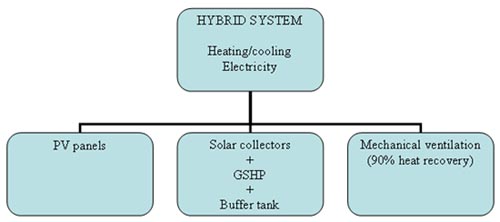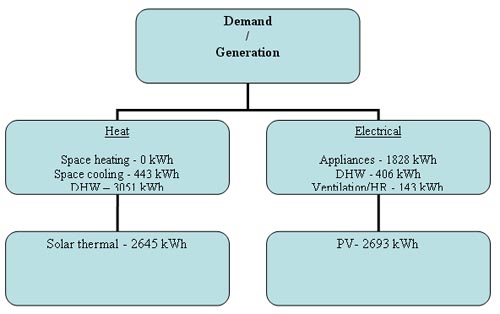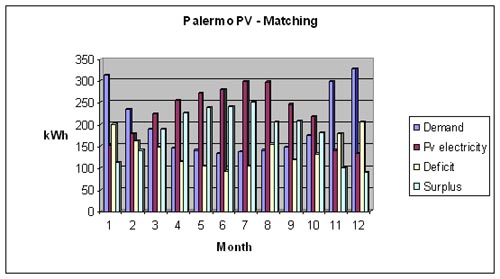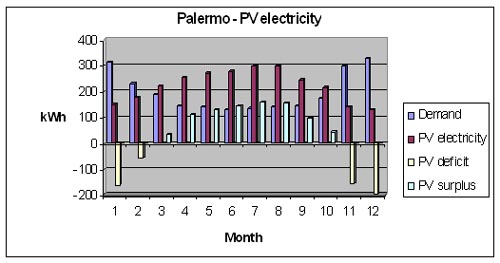Summary of previous results and annual simulations
We have conducted simulations on annual or monthly basis for various energy systems or hybrid combinations of such systems [see annual reports - a) yearly report on solar thermal - seasonal storage, b) report on yearly evaluation of hybrid combination of heat pump, solar collectors and storage tank, c) report on PV yearly evaluation, d) report on annual evaluation of wind energy]. We included a financial analysis in each case looking at the viability of the systems taking into account feed-in tariffs and renewable heat incentives. We also considered how some of the key parameters could affect the financial aspect of it in the future.
♦ Electricity demand:We have introduced an hourly demand calculated using excel.
♦ Domestic hot water (DHW): The demand was calculated using excel
♦ Preliminary work - Building design:: We have used ESP-r to model a low energy consumption dwelling using passive standard insulations and building components. We have conducted a detailed analysis of the influence of passive solar gains and optimised the size of the glazing area facing south, as well as the use of shading when needed.
We have introduced higher thermal mass within the building structure to take advantage of the lower night-time external temperature in order to keep the internal part of the building cooler during summer days.
We have evaluated the space heating and cooling demand per unit area for the dwelling. For further info see the ESP-r summary and the ESP-r analytical report
♦ Mechanical ventilation: Mechanical ventilation with heat recovery runs in order to provide 0.3 ac/h. Simulations were done using ESP-r. Mechanical ventilation heat recovery systems are considered part of the hybrid energy system as they are using an active element (fan) to recover heat from exhaust to inlet ducts in order to preheat or pre cool fresh air introduced to a building thus reducing significantly the heating /cooling load. For further info see the ESP-r summary and the heat recovery background info.
♦ Ground duct ventilation: We have simulated the effect of ground duct ventilation which is a form of active heat exchanger using the ground to reduce the summer cooling load. We found that the system can be quite effective but was not needed because the cooling demand is relatively small in order to justify the cost of such a system. Therefore, we have used the thermal mass which is actually a very effective way in order to reduce your cooling load. For further info see the ESP-r summary and the heat recovery background info.
♦ Solar water heating: DHW demand We have evaluated the annual contribution of solar collectors and decided to use a 2.8m2 evacuated tubes solar thermal system.
♦ Thermal storage: We use a standard water tank to store heat from solar collector and provide DHW at 45°C. The temperature for DHW can be lowered to 45C by using UV-C light system to disinfect and prevent risks of legionella. For further info see the report on yearly evaluation of hybrid combination of heat pump, solar collectors and storage tank. We considered seasonal storage as well but concluded that it would be ineffective for our case-study. For further info see the yearly report on solar thermal - seasonal storage.
♦ Wind: We concluded that micro-wind would not work in Palermo unless the dwelling was situated in an exceptionally well exposed rural site, which would not be representative of a standard case. The capacity factors were too small due to a relatively low average wind speed in Palermo but also because in suburban environment the effective wind speed is further decreased due to the environment surrounding the turbine. For further info see the report on annual evaluation of wind energy.
♦ PV: We have obtained that PV panels could provide the adequate electricity demand required. The financial aspect of PV is greatly influenced by feed-in tariffs in place as well as potential future cost reductions. The total capacity used is 2.1 kWp (report on PV yearly evaluation)
♦ CHP / bio-fuel boilers: CHP was not considered as standard units mostly operating on gas which is a fossil fuel and this would not fit our objective to design a low-carbon dwelling using essentially renewable sources of energy. In addition there is no space heating demand, so no need to also consider bio-fuel boilers such as wood pellets. New regulations in most urban areas also prevent the use of fuel creating smoke.
Key parameters of HYBRID energy system
The HYBRID energy system used in Palermo is the following one:

♦ The thermal demands, after taking into consideration the contribution of the ventilations are:
· Space heating = 0
· Space cooling = 443 kWh
♦ PV: Type: monocrystalline PV module BP4175T produced by the BP Solar.
· Efficiency of module = 14%
· Dimensions = 1587mm * 790mm * 50mm
· Power output = 175Wp
· Capacity: 12 PV panels so we have a power output of 2.1 kWp in order to cover our demand.
· Total area 15.04 m2
♦ Solar collectors: We have used a 30 tube solar panel - high efficiency double wall evacuated tube solar collector.
♦ Water tank: Type: 500 x 1500 245 litre twin coil vented copper cylinder
· Capacity = 245 litres
· Storage T = 45C
♦ Mechanical Ventilation Heat Recovery: Type: Ventos 50 DC Stand-Alone Comfort Ventilation 'MVHR' Unit
· Capacity = 3 ac/h
· Consumption = 15W
Results
The following figure represents the summary of the demand versus generation

The following graph shows the electricity generation from the hybrid system. The simulations were done using HOMER on hourly basis. We have compiled monthly the electrical demand, the PV production, the deficit and surplus (all in kWh). Deficit is shown as negative numbers and surplus as positive numbers.
The yearly balance is a small surplus of 461 kWh. 
Due to the fact that only PV has been retained to generate renewable electricity we have a significant temporal mismatch based upon hourly calculations:
- The PV deficit is 1715 kWh
- The PV surplus is 2176 kWh
As we are connected to the grid, this mismatch is not critical in terms of matching the demand through the periods of deficit.Note the difference with monthly simulation results:

Results using monthly simulation show smaller deficit and surplus (see above)
- The PV deficit would be 567 kWh
- The PV surplus would be 884 kWh
Potential problem on large scale:
Should a very large amount of dwellings be equipped in a similar manner it may be the case that during surplus periods the grid can receive then a large amount of electricity rapidly and need a scheme to predict and manage such situations with the rest of the grid generation. Such operation is likely to be more effective (cost-wise at least) on a community basis rather than individual basis.
Conclusions
The results obtained for Palermo can be summarised as follows:
- We achieved to create a low-carbon hybrid energy system which allows matching the thermal and electrical demands
◊ Solar PV
◊ Solar collectors for water heating
◊ Mechanical ventilation (90% HR)
- It is possible to eliminate heating demand through
◊ Efficient use of passive solar gains
◊ Mechanical ventilation (90% heat recovery)
- The cooling demand was reduced to 443 kWh for our 122m2 dwelling through:
◊ Use of thermal mass and increase the cooling setpoint temperature to 27°C instead of 25°C --> 78% reduction
◊ Ventilation --> 25.4% reduction
◊ Shading --> 27.7% reduction
- Electricity production by PV requires 2.1kWp
- Small-wind could not provide enough electricity in the case considered due to low capacity factor
- Electricity demand and generation mismatch is large and could be difficult to manage on larger scale
- Water heating using solar collectors covers 87% of the heat demand. Increasing the system size would have limited benefits as a large proportion of additional heat would be surplus.
- Small-wind was not adequate due to low capacity factor
- Ground duct ventilation was investigated but was not used
- Seasonal storage was not considered because the space heating demand did not justify it
- The financial analysis reveals that feed-in tariffs and RHI are necessary to make renewable systems viable.
| 